Microsystem Technologies
MIPE2022. 2022 JSME-IIP/ASME-ISPS Joint Conference
MIPE2022 special issue
In-process monitoring of atmospheric pressure plasma jet etching using a confocal laser displacement sensor
Takeru Tomita1, Kenta Nakazawa1, Takahiro Hiraoka2, Yuichi Otsuka2, Kensuke Nakamura2 & Futoshi Iwata3
1 Graduate School of Integrated Science and Technology, Shizuoka University
2Ushio Inc
3Research Institute of Electronics, Shizuoka University
大気圧プラズマジェットを照射してエッチングが進行している部分のエッチング深さをインプロセスモニタリングが可能な共焦点レーザー変位計を開発しました.さらに,開発した共焦点レーザー変位計を用いて,エッチングが進行して加工点の深さが増加していくことをモニタリングすることに成功し,目的のエッチング深さに達した時に大気圧プラズマジェット照射を停止することでエッチングの精度を向上させました.微細加工するために大気圧プラズマジェットはガラス管を熱引き加工して開口直径が10 µmに先鋭化させたノズルを用いました.ガラスノズル内にワイヤ型の高電圧電極を挿入し,アルゴンガスを導入して放電し,ノズル先端から大気圧プラズマジェットを照射しました.共焦点レーザー変位計は,計測に用いる光源波長に対応した狭帯域フィルタを用いてプラズマ発光を遮断することで発光によるノイズを低減しています.また,スポット位置を90 Hzで変調することで,電磁ノイズに起因する信号のノイズをフィルタによって除去することを容易にしています.
開発した共焦点レーザー変位計の応答時間をステップ変位試験によって計測し,0.2 µmの変位を計測試料に与えた場合に,応答時間は0.11 sでした.これは,エッチングレートが0.4 µm/s程度であることを考慮すると,十分にエッチングをモニタリングできる応答時間です.また,ステップ変位を0.2 µm,0.15 µm,0.10 µm,0.05 µm,0.005 µmと変化させた場合,0.01 µmのステップ変位も十分に判別することができ,分解能は0.01 µmとなりました.エッチング試験をしまして,形状は基板平行方向に楕円形状となり,エッチング深さが10 µmの時に半値全幅は短軸で44 µm,長軸で83 µmとなりました.エッチング深さをモニタリングし,目標エッチング深さに達した時にエッチングを停止した時,複数回実施したエッチング深さの平均値が10.0 µm,最大値が10.7 µm,最小値が9.2 µmとなりました.なお,モニタリングしない場合は,平均値が9.6 µm,最大値が10.7 µm,最小値が7.2 µmとなりました.モニタリングすることでエッチング深さの標準偏差は50%小さくすることができ,インプロセスモニタリングによってエッチングの精度を向上させることを示すことができました.
We have developed a confocal laser displacement sensor that enables in-process monitoring of the etching depth of the area where the etching is progressing by irradiating an atmospheric pressure plasma jet. Furthermore, using the developed confocal laser displacement sensor, we succeeded in monitoring the etching progress and the increase in the depth of the processing point and improved the etching accuracy by stopping the atmospheric pressure plasma jet irradiation when the desired etching depth was reached. For microfabrication, the atmospheric pressure plasma jet used a nozzle with a 10 µm diameter aperture, which was made by heat-drawing a glass tube. A wire-type high-voltage electrode was inserted into the glass nozzle, argon gas was introduced to discharge, and an atmospheric pressure plasma jet was irradiated from the tip of the nozzle. The confocal laser displacement sensor uses a narrow band filter corresponding to the wavelength of the light source used for measurement to block the plasma emission, thereby reducing noise due to the plasma emission. The spot position is modulated at 90 Hz to facilitate filtering out signal noise caused by electromagnetic noise.
The response time of the developed confocal laser displacement sensor was measured by a step displacement test, and the response time was 0.11 s when a 0.2 µm displacement was applied to the measured sample. Considering that the etching rate is about 0.4 µm/s, this response time is sufficient to monitor etching. When the step displacement was varied from 0.2 µm, 0.15 µm, 0.10 µm, 0.05 µm, and 0.005 µm, the step displacement of 0.01 µm could be sufficiently discriminated and the resolution was 0.01 µm. An etching test was performed, and the shape became an ellipse in the parallel direction to the substrate, and the full width at half maximum was 44 µm in the short axis and 83 µm in the long axis when the etching depth was 10 µm. When the etching depth was monitored and etching was stopped when the target etching depth was reached, the average, maximum and minimum etching depths were 10.0 µm, 10.7 µm, and 9.2 µm, respectively. Without monitoring, the average, maximum and minimum values were 9.6 µm, 10.7 µm, and 7.2 µm, respectively. With monitoring, the standard deviation of etching depth could be reduced by 50%, indicating that in-process monitoring improves etching precision.
論文はコチラ(外部サイトへジャンプします)

